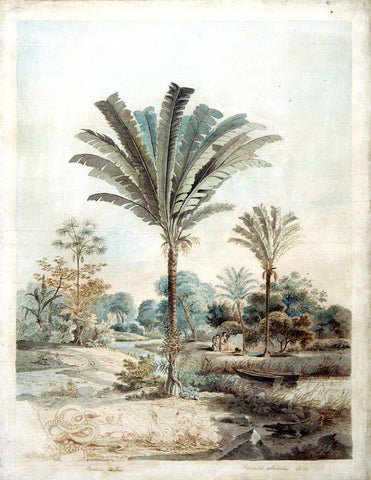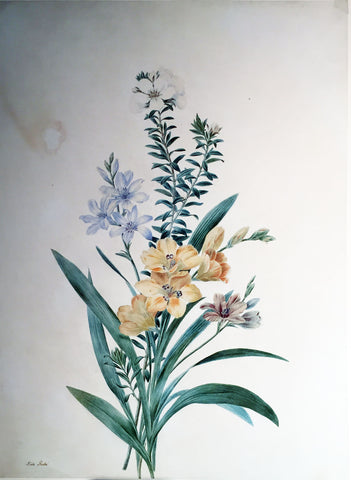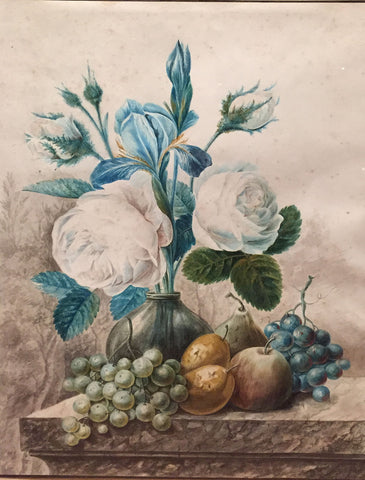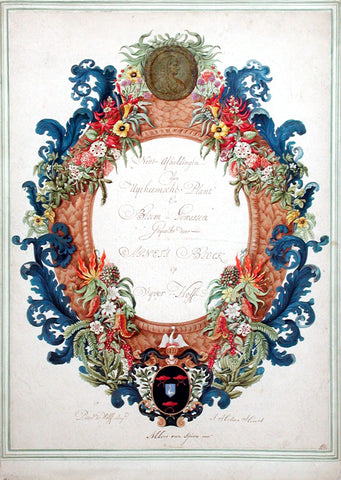
Carl Friedrich Philipp von Martius (1794-1868) and Johann Moritz Rugendas (1802-1858), A Brazilian Landscape with Indians encamped...
Carl Friedrich Philipp von Martius (1794-1868) and Johann Moritz Rugendas (1802-1858)
A Brazilian Landscape with Indians encamped under palms by a river, a snake and crocodile in the foreground
Pencil, ink, and watercolor on paper
Inscribed along lower margin: Manicaria Saccifera/Desmoncus orthacanthos Tab:98
Paper size: 18 1/2 x 14 1/2 in.; framed size: 28 5/8 x 24 1/8 in.
Literature: C. F. P. von Martius, Historia Naturalis Palmarum, II (De Brasiliae Palmis Singulatim) (Leipzig, 1823-1850), pp.87, 140-141, pl.98 (‘Manicaria Saccifera/Desmoncus orthacanthos’).
This remarkable watercolor is a study for plate 98, volume two of Martius’s exhaustive work, Historia Naturalis Palmarum. The plate credits the lithographer (‘C. Hess in lap. del’) working from the author’s model (‘Martius palm ad nat.’). The snake and crocodile are omitted on the plate. If Martius provided the original sketches of the two palms (as credited in the plate), the present watercolor may nevertheless have been worked up by Johann Rugendas for publication.
A Brazilian Landscape with Indians encamped under palms by a river, a snake and crocodile in the foreground
Pencil, ink, and watercolor on paper
Inscribed along lower margin: Manicaria Saccifera/Desmoncus orthacanthos Tab:98
Paper size: 18 1/2 x 14 1/2 in.; framed size: 28 5/8 x 24 1/8 in.
Literature: C. F. P. von Martius, Historia Naturalis Palmarum, II (De Brasiliae Palmis Singulatim) (Leipzig, 1823-1850), pp.87, 140-141, pl.98 (‘Manicaria Saccifera/Desmoncus orthacanthos’).
This remarkable watercolor is a study for plate 98, volume two of Martius’s exhaustive work, Historia Naturalis Palmarum. The plate credits the lithographer (‘C. Hess in lap. del’) working from the author’s model (‘Martius palm ad nat.’). The snake and crocodile are omitted on the plate. If Martius provided the original sketches of the two palms (as credited in the plate), the present watercolor may nevertheless have been worked up by Johann Rugendas for publication.
Martius’s Historia Naturalis Palmarum was based on his travels in Brazil with Johann Baptist von Spix from 1818 to 1820, but expanded, in a third volume (Expositio Systematica), to include all species then known worldwide. The majority of drawings of palms for the second volume, dedicated to Brazilian palms, were credited to Martius with just a few landscapes, representing areas not traveled over by Martius, taken from works by Frans Post and Johann Moritz Rugendas. As with the present watercolor, Rugendas probably worked up many of Martius’s sketches for publication.
King Maximilian Joseph of Bavaria sent Martius, a botanist, with Spix, a zoologist, to Brazil in 1817 in the suite of the Archduchess Leopoldina. The team investigated the natural history and tribal Indians and traveled extensively from Rio de Janeiro to Sao Paulo before making their way north, inland to Montes Claros and the Upper Sao Francisco, across to Salvador de Bahia and then northwest to Para. They became the first non-Portuguese Europeans to obtain permission to visit the Brazilian Amazon, starting upstream in August 1819. They split up in December, Martius ascending the Japura for two months reaching territory close to the frontier with modern-day Colombia, before reuniting at Barra (Manaus) in March 1820 and returning to Belem. From there, they sailed for Europe with a vast collection of natural history specimens and Indian artifacts.
The journey was the subject of their co-authored Reise in Brasilien, published in three volumes with an atlas (Munich, 1823-1832) and spawned Martius’s two monumental works on natural history, Historia Naturalis Palmarum and the mammoth Flora Brasiliensis, the latter published between 1840 and 1906, with just one third published by the time of Martius’s death in 1868.
King Maximilian Joseph of Bavaria sent Martius, a botanist, with Spix, a zoologist, to Brazil in 1817 in the suite of the Archduchess Leopoldina. The team investigated the natural history and tribal Indians and traveled extensively from Rio de Janeiro to Sao Paulo before making their way north, inland to Montes Claros and the Upper Sao Francisco, across to Salvador de Bahia and then northwest to Para. They became the first non-Portuguese Europeans to obtain permission to visit the Brazilian Amazon, starting upstream in August 1819. They split up in December, Martius ascending the Japura for two months reaching territory close to the frontier with modern-day Colombia, before reuniting at Barra (Manaus) in March 1820 and returning to Belem. From there, they sailed for Europe with a vast collection of natural history specimens and Indian artifacts.
The journey was the subject of their co-authored Reise in Brasilien, published in three volumes with an atlas (Munich, 1823-1832) and spawned Martius’s two monumental works on natural history, Historia Naturalis Palmarum and the mammoth Flora Brasiliensis, the latter published between 1840 and 1906, with just one third published by the time of Martius’s death in 1868.
Please feel free to contact us with questions by phone at 215.735.8811,
or by email at loricohen@aradergalleries.
We Also Recommend





